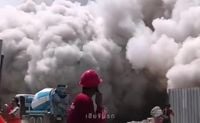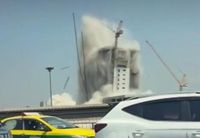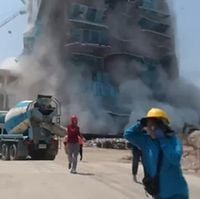On March 28, 2025, residents of Sakhalin experienced a terrifying earthquake while vacationing in Thailand, with the epicenter located in Myanmar. This significant seismic event registered a magnitude of 7.7, causing widespread panic and destruction.
The tremors were felt across Southeast Asia, particularly in Bangkok, where they reached a magnitude of 6. Eyewitness accounts from the popular tourist destination of Pattaya described the chaotic scene as buildings shook and water splashed from swimming pools. "In Pattaya, the shaking was so intense that it felt like my head was spinning. I looked around, and water was sloshing in bottles, while chairs moved in my apartment," recounted local resident Ekaterina.
In the northern part of Pattaya, reports indicated that furniture was displaced, with some witnesses stating that beds were moving across the floor. As fear gripped the area, many tourists and locals rushed outside to escape potential danger.
The situation escalated in Bangkok, where the tremors prompted a mass evacuation of skyscrapers, condominiums, and hotels. Panic ensued as people flooded the streets, with some noting that the shaking was so severe it caused a newly constructed skyscraper to sway dangerously. Eyewitnesses captured videos of the destruction, showcasing the chaos that unfolded.
As rescue operations commenced in Myanmar, the full extent of the damage was still being assessed. Reports indicated that significant structural damage had occurred, including the collapse of a bridge over the Irrawaddy River and the destruction of several homes. In Bangkok, a 30-story building under construction was reported to have fallen, trapping over 40 workers beneath the rubble.
In a separate account, residents from Kursk, also vacationing in Thailand, shared their experiences. Anna, a resident of Kursk, described the initial confusion as they felt the building shake. "At first, we didn’t understand what was happening. Everything was shaking, and we rushed into the corridor, where staff directed us downstairs. We met a Russian man who had experienced an earthquake before and knew what to do," she explained. He advised them to put on shoes to protect their feet in case of broken glass and to find a safe location away from windows.
Despite the chaos, Anna noted that the Thai locals expressed disbelief, stating they had never experienced such a powerful earthquake before. "We were just in Bangkok for a tour the day before, and now we see videos of the destruction. It’s hard to comprehend how this could happen," she said.
Meanwhile, a flight from Moscow's Vnukovo airport landed safely in U-Tapao, near Pattaya, almost ten minutes ahead of schedule. The Azur Air flight arrived at 02:12 Moscow time, according to dispatchers. However, in light of the earthquake, all airports in Thailand implemented flight restrictions, and Prime Minister Chinavat declared a state of emergency.
As of March 28, estimates suggested that up to 2,000 Russian tourists were in Bangkok, with many more in popular vacation spots like Pattaya and Phuket. Fortunately, no injuries among Russian tourists had been reported as of that time. Tour operators indicated that vacationers were continuing their trips as usual, with no signs of panic or significant destruction in these areas.
Despite reports of airport closures, the Association of Tour Operators of Russia (ATOR) stated that airports were still operating normally, although delays were expected. Aeroflot confirmed that they had not received any official notifications regarding airport closures and that their flights were operating on schedule.
The Thai government warned residents to be prepared for possible aftershocks in the following 24 hours. As the situation unfolded, authorities continued to assess the damage and prepare for any further seismic activity.
In the aftermath of the earthquake, locals took to social media to share their experiences. Many expressed disbelief at the intensity of the tremors, with comments such as, "My bed in Pattaya was running around the room," and, "I’m watching TV, and it’s swaying. It felt like the table I was sitting at was walking." These sentiments reflected the shock and confusion that many felt during the event.
As rescue efforts continued in Myanmar and inspections were conducted in Bangkok, the focus remained on ensuring the safety of all residents and tourists. The Thai authorities emphasized the importance of preparedness in the face of potential aftershocks, urging everyone to remain vigilant.
In conclusion, the earthquake in Southeast Asia serves as a stark reminder of the region's seismic activity and the need for preparedness in the face of natural disasters. As communities begin to recover, the resilience of those affected will be crucial in navigating the aftermath of this powerful event.








